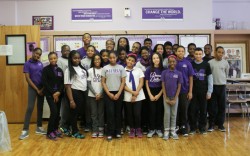By YOVANNA GARCIA
Mott Hall Bridges Academy Principal Nydia Lopez took the stage in front of 195 inner-city students on Jan. 28 to announce that a crowdfunding campaign to send the middle school class on a trip to Harvard had received over $1 million in donations.
Brandon Stanton’s Humans of New York, a massively popular photo blog dedicated to posting photos of the everyday New Yorker published a now-viral image of Vidal Chastanet, a 13-year-old boy from Brownsville, Brooklyn, who identified his principal as the most influential person in his life. Stanton was so inspired by the words of the young boy that he travelled to the middle school where Lopez works.

There, he was witness to one of the nation’s poorest, most crime-ridden neighborhoods.
News of Vidal’s photo and school cast a spotlight on children living in poverty and generated reactions from around the globe, including right here at Ramapo College.
“Racial inequality is embedded in the culture of our society, which disproportionately separates working class African-Americans,” said freshman Grace Maute, who heard about the Humans of New York campaign. “I think it’s a noble cause that sheds light on issues that are too often overlooked.”
For many, the image of an impoverished child, a child living in circumstances that lack access to basic needs and social services in the United States, is unfathomable. But for students like those of Brownsville, poverty is right in their backyard and can be found nationwide.
In fact, more than 16 million, or 22 percent, of children in the United States live in families with incomes below the federal poverty level of $23,550 a year for a family of four, reports the National Center for Children in Poverty.
The face of poverty does not always have a rural backdrop or only exist in other parts of the world — statistically, according to Poverties.org, as nearly 1/2 of African and Asian populations are becoming urbanites, and more than three-fourths of Latin America already is.
Throughout the course of history, it was clear that African-Americans face greater barriers to employment due to the cultural climate that deemed black bodies as less valuable than all other race-based identity groups.
For children such as those of Brownsville, a community where the median household income in 2011 was $31,252, lack of opportunities exist in most aspects of their lives. They are often faced with chronic poverty that does not even allow them to play in their neighborhood due to the high crime rate.
Stanton, who does not usually meddle with his photo subjects, created a crowdfunding campaign that would help to raise money for the students to attend college trips to Harvard. In just a week of fundraising, the money raised had exceeded the initial goal of $100,000 by 1,000 percent.

The money allows Chastanet’s sixth-grade class to visit Harvard for the next 10 years, begin a scholarship fund for college and establish a summer program that will give these inner-city students an opportunity to travel and experience.
For students at Ramapo College, the fundraiser was just one testament to the good that can come from an act of kindness.
“Poverty is not just about being able to afford a basic food basket, but an issue on lack of civil and political rights not often afforded to city people,” said junior Leslie Navas. “I could not be more happy for those children. They deserve every and each opportunity they receive from the generous donations.”
I actually saw that post on Instagram and thought to myself how great of a principal she was. Such a touching story, and I’m glad that you included the images of the children. Seeing the statistics on families who are living in poverty broke my heart, but it was needed in order to grasp the concept of how some families live. I thought your article was very well written and followed a chronological order that made the story fall directly into place. The closing quote was a very strong way to end this piece.